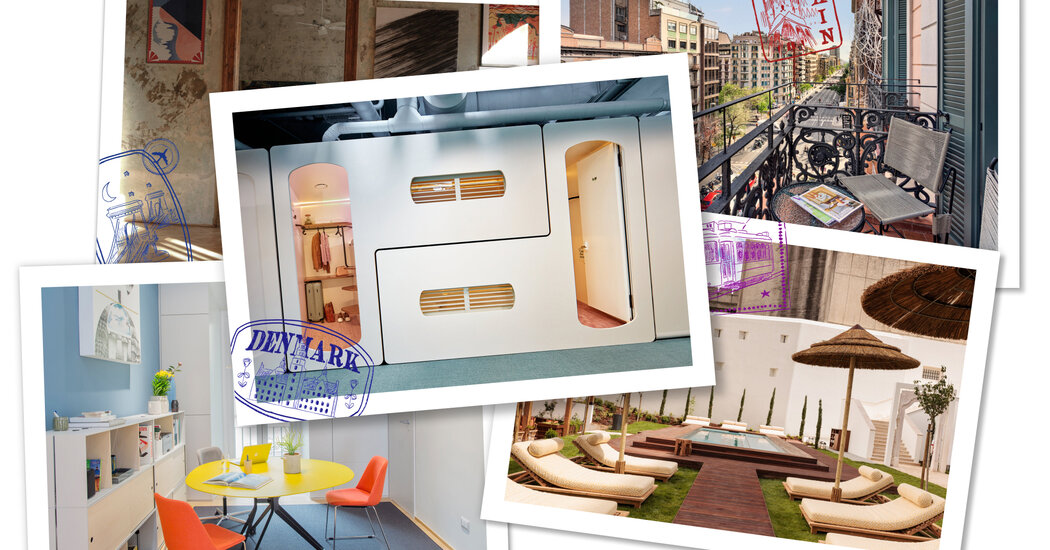Finding a reasonably priced hotel with character in the heart of popular European cities isn’t always an easy task. Our Europe-based contributors scoured the hotel scene in 15 cities in search of stylish lodgings that won’t break the bank. (Some even have free breakfast and rooftop pools.) The hotels below usually have rooms available for less than $300 per night, with two caveats: Rates often surge during busy travel moments, and the dollar is currently on the wane.

Amsterdam
Hotels in Amsterdam have taken center stage in an ongoing struggle against overtourism: With a halt on new hotel permits, the city wants to limit crowds along its canals and in its museums.
Dam Square, the bustling heart of Amsterdam, has it all: the Royal Palace, the National Monument, the high-end department store De Bijenkorf, Madame Tussauds and, yes, lots and lots of tourists. Off the square is a narrow street, the Nes, offering an unexpected patch of urban calm. Tucked among theaters, restaurants and cafes, lies Hotel V, a modern, 4-star hotel sporting leather armchairs and a staircase lined with vintage theater posters. The 43 rooms range in size from a small 200-square-foot “comfort” room to a 650-square-foot suite. Adjacent to the hotel is their restaurant, the Lobby, serving up breakfast, lunch and dinner. — Noëlle de Leeuw
On a tree-lined street in the Oud-Zuid neighborhood, nestled between the city’s most stylish shopping street and Museum Square, is Jan Luyken, a boutique hotel in a 19th-century townhouse. When booking a stay in one of the hotel’s 62 rooms, you get access to the entire townhouse and its facilities — including a velvet couch in a library area, a tranquil gym, an outdoor patio and bicycles to explore Amsterdam in true local fashion. Breakfast is also included. Rooms range from a “snug single” for the solo traveler to a spacious studio with a private entrance. The floors are all accessible by elevator, and four-legged companions are welcomed just as much as their human owners. — Noëlle de Leeuw

Athens
From stylish and bohemian boutique hotels to renovated beachfront villas, new hotels are popping up across the Greek capital, offering visitors respite from the crowded historical city center.
Overlooking the Acropolis Museum and within walking distance of the city’s main tourist attractions, the COCO-MAT Athens BC offers a 5-star hotel experience — packed with amenities, including a gym, spa, rooftop pool and library — at a reasonable price. There is a wide range of accommodations, from cozy and double rooms to large loft suites with bright modern décor. The restaurant serves breakfast and homemade dishes for lunch and dinner. Concierge services are available to book excursions, sightseeing tours, restaurants and babysitting for families traveling with children. — Ceylan Yeğinsu
In the lush green suburb of Kifissia, in northern Athens, the boutique Say Hotel provides an authentic urban retreat from the city’s bustling tourist areas with elegant modern rooms and a rooftop restaurant offering sweeping views, signature cocktails and farm-to-table Mediterranean cuisine. There’s also an all-day garden brasserie that serves local Greek wine and fresh, light fare. Other amenities include a 24-hour front desk, concierge service and a gym. Within walking distance are the designer boutiques, traditional restaurants, bars, cafes and vast scenic parks that abound in this affluent area. — Ceylan Yeğinsu

Barcelona
A crackdown on short-term rentals has helped push hotel rates higher across Barcelona, but there’s still a wide range of accommodations at all points on the price spectrum.
On the quieter edge of the trendy Born neighborhood, and a block from the Ciutadella park, this unpretentious hotel is built into an old palacio, the carving up of which has resulted in rooms that are wonkily shaped but far more interesting than those at your average budget hotel. Spartan, all-white furnishings and tongue-in-cheek messages on the throw pillows contrast nicely with stately architectural elements like high ceilings, ornate moldings and wrought iron balconies. And while the color-changing tubular curtains that guard each room’s entryway are hard to explain, the free snacks in the sitting areas on each floor more than make up for them. — Lisa Abend
In a fin-de-siècle building in the upscale Dreta de l’Eixample neighborhood, the One Shot has stylish touches — luscious colors, sleek designer lamps, mod fabrics — that make the place feel more expensive than it is. The rooms feature both traditional Catalan elements, like brightly patterned tile floors and enclosed balconies, and some welcome modern touches, like rainfall shower heads. There’s not much in the way of common space beyond a corner reception desk, but an unbeatable location — just a couple of minutes from the Passeig de Gràcia, the broad boulevard home to Gaudi’s Casa Milà and a lot of upscale shopping — means there is no shortage of restaurants and bars nearby. — Lisa Abend

Berlin
Given Berlin’s status as one of the major capitals of Europe, the city’s hotels are surprisingly affordable, whether you opt for one of the popular global chains clustered around the tourist attractions or a glitzy one-off boutique in a trendier neighborhood.
In a quiet part of the Friedrichshain neighborhood, this boutique hotel is a short tram or subway ride to some of Berlin’s optimal areas for dining, nightlife and shopping, including the adjacent neighborhoods of Prenzlauer Berg and Kreuzberg. Each room has a unique design enhanced by thoughtful touches, such as bathroom-floor heating, body wash and shampoo by the British luxury brand Molton Brown, Nespresso coffee makers and Bluetooth speakers. A sauna and a relaxation lounge on the top floor offer delightful views of the city’s rooftops and are available daily until 11 p.m. Befitting a city that genuinely never sleeps, the gym is open 24/7, as is a convenience shop (called a späti in German, from the word for “late”) selling drinks, toiletries and snacks, including a selection of hard candies. — Valeriya Safronova
The Hoxton’s colorful, quirky Art Nouveau-inspired décor makes an immediate impression; the lobby is full of cozy nooks and stylish details that encourage mingling and lingering. Upstairs, the rooms are more minimalist but equally chic and, most importantly, very comfortable. The hotel, in the west of the city, is slightly out of the way for visitors eager to explore Berlin’s best-known sights in the center. Nevertheless, a transit hub with numerous tram, bus, subway and aboveground train connections is a five-minute walk away, making the Hoxton a convenient jumping-off point for reaching various corners. The House of Tandoor, on the ground floor, serves Indian cuisine, with a special brunch on weekends presented thali-style, or on a large platter with a broad selection of small dishes. There’s no spa or gym, but a nearby gym offers Hoxton guests free access. — Valeriya Safronova

Budapest
The hotel scene in Budapest is every traveler’s dream, with a plethora of conveniently located options that offer evocative architecture, reasonable prices and access to thermal waters.
Kozmo Hotel is in many ways emblematic of modern-day Budapest: an architectural and historical marvel, stunningly renovated, that provides an array of comforts at a reasonable price. (An often reasonable price, that is, since rates do occasionally surge.) The hotel, in the outer part of one of Budapest’s more eclectic districts, occupies a building that was designed in the early 1900s as a telecommunications center; it opened during the pandemic after a major revamp. While less central than other options, it has amenities galore: a high-end restaurant, a stylish bar, an interior courtyard, and a spa and fitness area that includes a sauna, a pool and a Jacuzzi. And just wait till you see its singularly magnificent staircase, now among the hotel’s many spacious communal areas. — Stephen Hiltner
Compared to the city’s many opulent and imposing hotels, Brody House is a study in contrasts: intimate and easy to miss while still feeling eminently of Budapest. The small boutique hotel, which sits in a charming neighborhood directly across from the Hungarian National Museum, has eight distinctive rooms, each named after an artist. The overall vibe is a fresh (and luxe) take on the gritty, mismatched aesthetic once ubiquitous in the city’s many ruin bars. Lacking the grand amenities of its larger competitors, the hotel offers a bar, a bistro and a curated selection of events that provide “bonhomie, creative collaboration and easy going mind-stretching.” Nearby you’ll find a bevy of first-rate cafes (including Kolibri), antique shops (some with fantastic vintage posters) and possibly the prettiest public library you’ll ever encounter. — Stephen Hiltner

Copenhagen
A surge of new openings in recent years has greatly improved the accommodations landscape in Copenhagen. Although Scandinavian taxes keep prices on the high side, Scandinavian culture means most hotels have bikes available for guests to rent.
The Japanese capsule meets Scandi chic in this recent addition to Copenhagen’s hotel scene. Housed in a former street-food market in the restaurant-packed Vesterbro neighborhood, the futuristic pods (called “hubs” here) are well designed, with just enough space to plug in a phone and sit up in bed. The bathrooms are shared but spotless, and come helpfully loaded with towels, toiletries and saunas for stretching out any cramped muscles. Automated check-in and wristbands that grant guests access to their rooms, storage lockers and the well-stocked bar make things frictionless, but the real-live “city host” (also known as a concierge) who is on the premises 24/7, as well as the colorful communal spaces designed for both work and relaxing, help mitigate any dystopian unease. — Lisa Abend
Located in the once tacky, now cool neighborhood of Amager, this hotel seems purpose-built for the digital nomad. There are some very hygge (170-square-foot) rooms, but most of the accommodations are light-filled loft apartments that function as both home and office, with fully equipped kitchens, good-sized work tables, and even the opportunity to choose the artwork on the walls. With abundant charging stations, staplers and rulers tucked in the desk drawers, and multiple on-site meeting rooms and co-working spaces, the place is clearly — and thoughtfully — designed for travelers who need to get business done. But the rooftop restaurant and cocktail bar, with views over the city, mean there’s room for fun, too. — Lisa Abend

Istanbul
In the expansive city that connects the two continents of Europe and Asia, the hotel portfolio is seeing significant growth, from large luxury establishments to smaller independent options for various budgets.
Situated in a beautifully restored 19th-century mansion in the heart of Istanbul’s central Pera district, the Adahan DeCamondo Pera offers an authentic boutique experience with a stunning rooftop terrace restaurant that overlooks the city’s Golden Horn waterway and historic peninsula lined with mosques and landmarks. The hotel’s rooms are spacious, with high ceilings and marble bathrooms, and on-site amenities include a gym, fitness space and meeting rooms. The Galata Tower and bustling narrow streets of the Beyoglu district, lined with shops, bars and restaurants are all within walking distance. — Ceylan Yeğinsu
Originally built in 1895 and renovated in 2021, RUZ has only 25 rooms, each with trendy décor incorporating details like exposed brick, vintage-style radios and heavy clay-red curtains. The hotel is home to the Red Balloon, a Michelin Bib Gourmand restaurant serving a menu that blends Mediterranean and Aegean influences. On the top floor, a cocktail bar offers breathtaking views of the city and the surrounding neighborhood, a bustling area with countless options for eating, drinking and shopping. RUZ sits off a lively pedestrian street called Istiklal Avenue and is an easy walk or tram ride to the historic center or the ferry terminal with boats regularly crossing to the city’s Asia side. As an added convenience, a funicular railway that shuttles riders to and from the harborside neighborhood of Karaköy is steps from the hotel. — Valeriya Safronova

Lisbon
Because of a flood of international travelers and expats over the last decade, this formerly budget-friendly metropolis of hills and churches has seen costs (and resentments) surge, though hotel rates remain a bit below those of the more famous European capitals — for now.
Príncipe Real is a strong contender for Lisbon’s coolest neighborhood. Not only does it enfold myriad contemporary cocktail bars, coffeehouses and concept stores, but the hilltop district is also home to atmospheric old-school Lisbon institutions like the house-museum of Amália Rodrigues — Portugal’s most beloved 20th-century singer — and the 19th-century botanical gardens. Casa de São Mamede adds yet another historical flavor to the mix: the Baroque. The family-owned hotel is housed in a stately stone mansion from the 1750s, and common areas are decorated with chandeliers, low armchairs, stained-glass panels and blue-painted azulejo tiles that pay homage to its 18th-century origins. And expansion plans are afoot: A new plant-filled courtyard will open this summer. — Seth Sherwood
If the word “convent” still evokes images of religious acolytes, strict discipline, spartan quarters and abstinence in all forms, you probably haven’t stayed at Locke de Santa Joana. Opened last year, the massive, minimalist-cool hotel occupies a 17th-century former convent that has been fully renovated and updated, both in its architecture and in its allowed behaviors. An international all-star team oversees the restaurants and bars, including the culinary director Nuno Mendes, who has helmed some of London’s top kitchens, as well as Spiritland, a chain of London cocktail bars known for their sound systems and D.J. sets. (A poolside lounge and a Japanese-style listening bar, complete with vinyl albums and myriad whiskeys, round out the boozy buffet.) An on-site archaeological gallery showcases historical relics found during its renovation, and a co-working space offers coffee and comfortable chairs. — Seth Sherwood

London
While the high-end redevelopments of historic buildings like the Old War Office, now a Raffles hotel, has garnered lots of attention, the English capital offers a number of more affordable gems for those comfortable in downsized rooms.
On lively Brick Lane, filled with Bangladeshi restaurants and vintage clothing stores, the Buxton houses 15 simple but stylish rooms above a convivial restaurant that serves seasonal French-inspired dishes. The most affordable rooms are small with inviting residential amenities such as espresso makers, bedside reading lamps, Bluetooth speakers and books on London from a local publisher. Provided they’re willing to climb its five stories, guests have access to a small rooftop deck with an herb garden and panoramic views. The ground-floor pub, with exposed brick walls and chalkboard menus, handles check-in and serves a small-plates menu including cheeses, sausages and tinned fish. Breakfast, which is included, features meats, cheeses, granola and savory croissants. — Elaine Glusac
A new hotel near the City of London, Ruby Stella cites Charles Dickens as inspiration and fills its buzzy lobby lounge with vintage and retro furniture. By contrast, guest rooms upstairs are minimal and bright, dominated by fluffy white bedding with wood wainscoting for warmth. Most are small — and the smallest, targeted to solo travelers, are windowless — with efficiently designed bathrooms behind glass walls fitted with curtains for privacy. The Germany-based Ruby group of hotels, which has properties in 13 cities across Europe, operates on what it calls a “lean luxury” philosophy, doing away with things like room service and mini bars to keep rates down while making its lobbies hubs of activity, including live music and D.J. sets. Ruby Stella’s cashless bar specializes in Negroni cocktails and light Italian fare such as pizza, which guests can also enjoy in an adjacent courtyard. — Elaine Glusac

Madrid
After missing Olympic bids in the early 2000s, in part because of hotel shortages, Madrid now has abundant properties for every purse in every neighborhood — and there’s typically a pool on the roof.
Given its prime location across the Plaza Isabel II from the Royal Opera, Ocean Drive Madrid is surprisingly a brand-new building, albeit one sensitively adapted to its centuries-old neighborhood. The irregular plot allowed for a V-shaped design (giving all rooms exterior views) and a lushly verdant garden with olive and lemon trees. Much of the lobby level and garden are given over to hippie-chic Mar Mía Restaurante, an urban beach bar and seafood grill. Beyond the larger corner suites and deluxe terrace room, other room categories are compact but smartly designed with warm wood and leather accents. The rooftop terrace and pool are exclusively for hotel guests. — Andrew Ferren
Since 2017, the five-star Barceló Torre de Madrid has been inconspicuously tucked into the first nine floors of the Torre de Madrid, one of Madrid’s most iconic buildings. Flooded with light through massive windows, the hotel’s diaphanous ground-floor restaurant and glamorous gilded bar merge with the street scene outside. Throughout this very urban hotel, the designer Jaime Hayon combined Arcadian playfulness (a sculpture of a top-hatted bear greets guests at the door) with sophisticated, cosmopolitan style. The spacious guest rooms feature curvy lines, snuggly fabrics and subtle color harmonies. There’s an indoor pool, a large gym and a sprawling breakfast buffet. Just outside, the grand and newly renovated Plaza de España links the old city (the Royal Palace) with the new (the world’s largest Zara store). — Andrew Ferren

Milan
With many chic, well-designed hotels, Milan can be a difficult city to navigate on a budget, especially during the fashion and design weeks when prices skyrocket.
Curtains of ivy cascading from a second-story terrace frame the entrance to Urban Hive Milano, a contemporary hotel in the heart of the fashionable Brera neighborhood, a short walk from the esteemed Pinacoteca di Brera museum and Parco Sempione. Rooms range from “Mini” singles ideally suited for the solo traveler, to “Cosy” doubles and spacious “Junior Sweet” suites, all with cherry-red rotary phones, walls adorned with decorative plates and modern bathrooms (some equipped with Dyson hair dryers). Ample co-working spaces, meeting rooms and lounges are available for the digital nomad, and the spaces also host a variety of workshops and events, including a monthly reading party and design-week D.J. sets. In the lobby, an Italian-style bar called Portico84 is open all day, for a morning cornetto and cappuccino or an evening Negroni. — Ingrid Williams
In an 18th-century building beside the Naviglio Grande canal, Maison Borella is a boutique hotel on the border of the lively Porta Genova neighborhood and Zona Tortona, the trendsetting epicenter of the city’s fashion and design weeks. A careful renovation preserved much of the property’s historical charm: timbered ceilings, exposed brick walls and original stone floors. Simply decorated rooms, from snug doubles to roomy canal-side suites, encircle a leafy central courtyard where guests sip morning espresso with a slice of cake from the breakfast buffet. In the evening, the on-site restaurant, Bugandé — the name, which means “the launderer” in the local dialect, is a tribute to the laborers who historically worked in the neighborhood — serves traditional dishes of the region to tables set in a handsome dining room. — Ingrid Williams

Paris
For a near-mythic city that ranks among the most touristed in the world, the French capital contains a surprising number of decent budget and midrange hotels, especially if you are willing to look beyond the most popular neighborhoods.
Hotels with speakeasy bars have been around for years now. But a cocktail bar that hides a secret hotel? That’s what you find at Oh la la!, a discreet, easy-to-miss crash pad amid the bakeries, convenience stores and street-food joints in Paris’s 11th Arrondissement. Among the blue banquettes and mirrored walls of the ground-floor bar — which serves French wines, mixed drinks and local craft beers — a bookshelf holding paperbacks by Sartre, Zola, Stendhal and other French heavyweights swings open to reveal a stairway leading up to the 16 simple, bright rooms spread over six floors. (There is no elevator.) If you can sacrifice quiet for classic Paris atmosphere, book one of the front rooms and drink in the views of the grand cafes and crowds of Place de la Bastille, where the French Revolution officially kicked off in 1789. — Seth Sherwood
Just the name “Montparnasse” conjures sepia-toned images of the Left Bank neighborhood’s 1920s and 1930s heyday, when it was a hub for the era’s writers and artists. Housed in a classic Parisian stone building with a chiseled facade and wrought-iron balconies, Hotel Lenox Montparnasse channels the Jazz Age with Art Deco touches — the lobby’s checkerboard floor, the rooms’ curvaceous furniture — and a plush Art Deco-style lounge. Pour yourself a glass of wine (€8) at the self-service bar, gaze at the mounted photos of famous Montparnasse denizens (Jean Cocteau, Fernand Léger) and grab a copy of “Man Ray in Paris” from the bookshelf. Suddenly you’re transported a century back in time. Or have a drink at Le Dôme, a cafe-restaurant where the art crowd used to meet; it’s at the end of the block. — Seth Sherwood

Rome
A glittering crop of new palatial luxury hotels has stolen the international spotlight lately in the Eternal City, but an array of smaller, more discreet three- and four-star options — including some elegant ones in historical edifices — are also tucked among Rome’s ancient ruins and monuments.
Whether you’re in Rome to visit monuments, snap up luxury goods, do some professional work or relax with a book, Hotel Anahi is well-located and well-equipped. A five-minute walk brings you to the Piazza del Popolo, one of Rome’s grandest public squares and home to multiple centuries-old churches, particularly Santa Maria del Popolo basilica, which houses works by Raphael, Bernini and Caravaggio. Two of Rome’s most famous shopping streets, Via di Ripetta and Via del Corso, are equally close. And within the hotel’s 19th-century building — whose rooms and common areas feature William Morris wallpapers, herringbone floors and other touches of late 1800s design — you can take advantage of the lobby’s antique desks, plush couches and selection of multilingual literary works. — Seth Sherwood
Bob Dylan, John Coltrane and Franz Schubert can be spotted — in vinyl-album form — hanging around the turntable-equipped, artwork-filled lobby of this chic and homey design hotel, which sits amid the foreign embassies and government offices of the Sallustiano neighborhood. Its warren of bright, airy common spaces feels more like a stylish Scandinavian living room. French Champagnes and Italian natural wines beckon from the lobby’s streamlined bar counter — for guests only — while books by Umberto Eco, Raymond Carver, Woody Allen and others grace the lobby shelves. The 11 rooms are tasteful medleys of wood, metal, stone and curvaceous molded plastic, thanks to furnishings by noted brands like Kartell, Arper, Ferm Living and Arrmet. — Seth Sherwood

Stockholm
Travelers to Stockholm, which encompasses fourteen islands, will find plenty of appealing options in the walkable, residential neighborhoods just outside the city center.
The Hotel Ruth has a lesson for anyone who still associates Scandinavian design with stark minimalism. This family-owned boutique hotel, which opened in 2021 in an area known as Sibirien in the residential Vasastan neighborhood, was designed to feel like the home of a chic Stockholmer, with polished parquet floors, quirky vintage furniture and colorful leaf-motif silk-screen prints by the Swedish artist Linnéa Andersson. Guest rooms feature floral-print headboards and glossy-tiled bathrooms with checkerboard floors, some with a Gustavian-style wardrobe or an original kakelugn, a tiled fireplace-like stove common in fin-de-siècle apartments (and prized in the local real estate market). In the restaurant, the ample morning buffet includes gravlax on Danish rye and Swedish meatballs, and in the evening, the bar lights dim for aperitifs with galettes served from the creperie next door. — Ingrid Williams
In a landmark building dating to 1780, the Nofo Hotel takes its name from the location: one block north of Folkungagatan on the southern island of Södermalm. The property, originally a brewery, is set around a sunny cobblestone courtyard where guests linger over coffee and waffles with blueberry jam from the breakfast buffet. In the evening, the Nofo Wine Bar takes over, serving wild-fermented cider from Stockholm producer Brutes, local Omaka I.P.A.s and a full menu, including a snack that has lately become ubiquitous in Stockholm: pickled cucumber topped with smetana (similar to crème fraîche) and honey. The eclectic rooms range from color-splashed singles with modern Scandinavian design to London-themed suites with Tom Dixon furniture and photos of Twiggy and the Beatles. — Ingrid Williams

Venice
Limited land, overtourism, restrictions on new hotel construction and a slew of popular festivals keep accommodation prices high for much of the year in Italy’s most enchanting city, though low-season visits and a smattering of scattered three-star gems and four-star bargains help save some euros.
You can tell that a family with longtime links to the Venice art world is running All’Angelo Art Hotel, located in a 17th-century palazzo practically next to Saint Mark’s Square and its celebrated basilica. Opening-night receptions for exhibitions by contemporary local and international artists fill the common areas every couple of months, and reproductions of paintings by Italian modernist pioneers like Giuseppe Santomaso and Emilio Vedova grace the guest rooms. Other forms of creativity are championed as well, courtesy of periodic live jazz performances and cocktail workshops in the plush restaurant-bar. If you can tear your eyes away from its postcard-worthy canal view, hoist the hotel’s signature Angelo drink and wish the hotel a happy birthday: It turns 100 this year. — Seth Sherwood
History and mystery converge at Hotel al Ponte Mocenigo. An unmarked stone doorway opens directly onto the adjacent slim canal, allowing visitors to pull up quietly by gondola or water taxi and slip discreetly into the five-century-old palazzo. (For those who prefer to arrive on foot, the hotel can be reached by a stone bridge.) And in the enclosed stone courtyard, a guests-only hideaway ringed by historical columns and statues, an ancient well bears silent witness to the Byzantine era. The storybook Venetian vibe continues upstairs and outside. Rooms are decorated with Murano-glass chandeliers and rich damask drapes, while the city’s most spectacular waterway, the Grand Canal, is just a few steps away — along with a convenient vaporetto (waterbus) station. — Seth Sherwood





